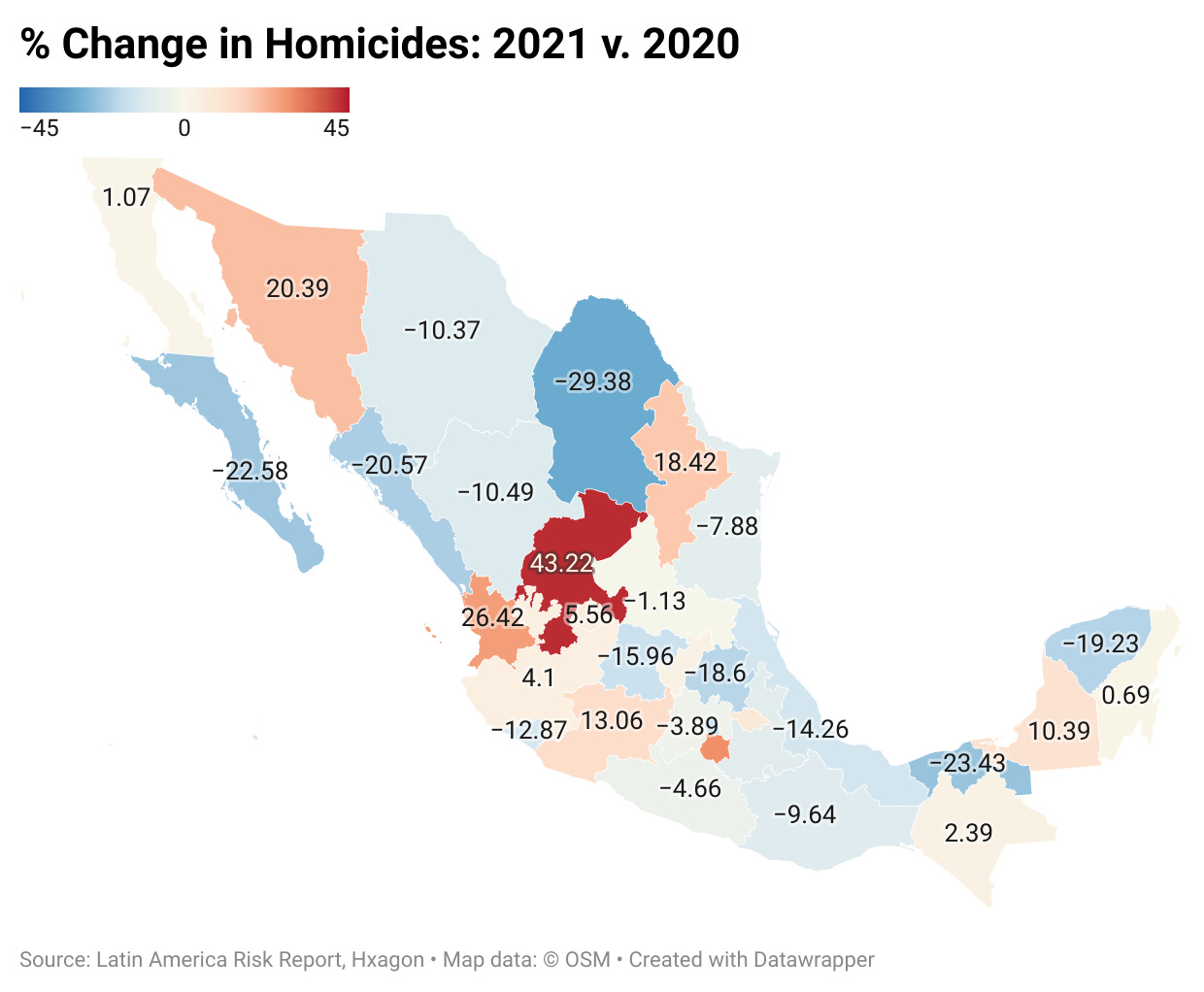Mexico - Review of 2021 security data
Mexico’s violence remains near peak levels, with hotspots including Zacatecas and Tijuana.
2021 was another violent year in Mexico. According to SESNP data compiled by Semaforo Delictivo, total homicides reached 28,262, equal to 22.4 homicides per 100,000 people. This is a 2% decline relative to 2020; however, homicides rates are still well above what they were 5 years ago. This time last year, the Latin America Risk Report emphasized that the marginal year on year change should not look past the stark increase in violence that occurred starting around 2006 and peaked in 2018 and 2019. The same is true this year.
For today’s newsletter, Lucy Hale compiled the 2021 homicide data into maps that show the distribution and severity of violence in Mexico. Despite a small shift in total homicide figures for Mexico, the violence is not evenly distributed and certain states observed significant changes in their security environment.
Takeaways from the data:
CJNG expansion continues driving violence.
In 2021, the most violent states in terms of total homicides were Guanajuato (2823), Baja California (2656), Estado de México (2346), Michoacán (2234) and Chihuahua (2056). Meanwhile the number of homicides relative to population (homicides per 100,000) was highest in Baja California (70.5), Zacatecas (69.7), Colima (64.8) and Chihuahua (55.6), and Sonora (54.3). All of these states are the site of CJNG expansion. Their clashes with rival groups in the states to which they expand are one of main causes for the sustained high levels of violence. Lopez Obrador has done little to respond.
Zacatecas is Mexico’s fastest deteriorating state.
For the second year in a row, Zacatecas had the largest increase in homicides out of any state in the country. In 2020, homicides grew 55 percent relative to 2019, and in 2021, homicides grew 43 percent relative to 2020. The rapid security deterioration in the state prompted López Obrador to deploy the National Guard to Zacatecas in late November, though it is unlikely it will make a substantial dent in overall violence in the state. The increase in violence over the past couple of years is the result of intensifying conflict between the Sinaloa Cartel and the CJNG over a state that sits at the intersection of northbound trafficking routes coming from Guerrero, Michoacán, Colima and Jalisco.
The data do not capture everything.
Quintana Roo experienced almost no change in homicides between 2021 and 2020 (less than 1 percent), yet the nature of the violence in the state changed dramatically. 2021 saw an unprecedented spike in violence in tourist zones, especially in and around Cancún. This trend is likely to continue into 2022, especially considering last week there were two fatal shootings in Playa del Carmen alone. Regardless of whether aggregate homicide numbers change for the state, the perception of increased violence in areas with foreign tourists threatens the tourism industry that sustains the state’s and much of Mexico’s economy.






Thanks for this update, Boz and Lucy. I had been meaning to dig into this data. I'm curious if either of you have any opinions on where this is headed. Without an effective security strategy coming from the state, is 2022 going to continue the trend of historically high homicide rates we've seen the last several years? What could bring the rate down in this context?